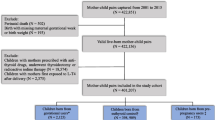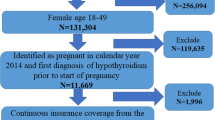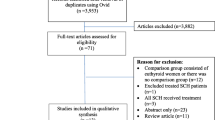Abstract
Introduction and Objective
The risk of seizure in offspring following prenatal exposure to levothyroxine is not well investigated. This study aimed to evaluate the association between levothyroxine treatment among pregnant women and the risk of seizure in their offspring.
Methods
This population-based cohort study included all pregnant women who delivered a live birth between January 2001 to January 2018, with a follow-up to December 2020, using data from the Hong Kong Clinical Data Analysis and Reporting System. Propensity score fine-stratification weighted hazard ratios (wHR) with 95% confidence intervals (CIs) were presented to assess the association between maternal levothyroxine use during pregnancy and seizures in children.
Results
Among 528,343 included mother–child pairs, 3044 children were prenatally exposed to levothyroxine at any time during the pregnancy period. A significantly increased risk of seizure was observed in children of the prenatally exposed group compared with the prenatally unexposed group (wHR 1.12, 95% CI 1.02–1.22). An increased risk of seizure was observed when comparing the prenatally exposed group with euthyroid mothers who had no history of thyroid-related diagnosis or prescriptions (wHR 1.12, 95% CI 1.02–1.23). However, no significant difference was observed between the prenatally exposed group and those previously exposed to levothyroxine but had stopped during pregnancy (wHR 0.97, 95% CI 0.66–1.44). No significant difference was observed in the sibling-matched analysis either (wHR 1.23, 95% CI 0.76–2.01).
Conclusion
The observed increased risk of seizure in children born from mothers exposed to levothyroxine during pregnancy might be due to residual confounding by maternal thyroid disease. The findings support the current guidelines on the safe use of levothyroxine treatment during pregnancy.


Similar content being viewed by others
References
Bernal J. Thyroid hormone receptors in brain development and function. Nat Clin Pract Endocrinol Metab. 2007;3(3):249–59.
de Escobar GM, Obregón MJ, del Rey FE. Maternal thyroid hormones early in pregnancy and fetal brain development. Best Pract Res Clin Endocrinol Metab. 2004;18(2):225–48.
Iskaros J, Pickard M, Evans I, Sinha A, Hardiman P, Ekins R. Thyroid hormone receptor gene expression in first trimester human fetal brain. J Clin Endocrinol Metab. 2000;85(7):2620–3.
Sahay RK, Nagesh VS. Hypothyroidism in pregnancy. Indian J Endocrinol Metab. 2012;16(3):364.
Alexander Erik K, Pearce Elizabeth N, Brent Gregory A, Brown Rosalind S, Grobman William A, Lazarus John H, et al. 2017 Guidelines of the American Thyroid Association for the diagnosis and management of thyroid disease during pregnancy and the postpartum. Thyroid. 2017;27:315–89.
Sander JW. The epidemiology of epilepsy revisited. Curr Opin Neurol. 2003;16(2):165–70.
ILAE Commission. Guidelines for epidemiologic studies on epilepsy. Commission on Epidemiology and Prognosis International League Against Epilepsy. Epilepsia. 1993;34(4):592–6.
Fisher RS, Boas WVE, Blume W, Elger C, Genton P, Lee P, et al. Epileptic seizures and epilepsy: definitions proposed by the International League Against Epilepsy (ILAE) and the International Bureau for Epilepsy (IBE). Epilepsia. 2005;46(4):470–2.
Arpino C, Domizio S, Carrieri MP, Brescianini S, Sabatino G, Curatolo P. Prenatal and perinatal determinants of neonatal seizures occurring in the first week of life. J Child Neurol. 2001;16(9):651–6.
Guerrini R. Epilepsy in children. Lancet. 2006;367(9509):499–524.
Tamijani SMS, Karimi B, Amini E, Golpich M, Dargahi L, Ali RA, et al. Thyroid hormones: possible roles in epilepsy pathology. Seizure. 2015;31:155–64.
Han JY, Lee IG, Shin S, Park J. Seizure duration may increase thyroid-stimulating hormone levels in children experiencing a seizure. J Int Med Res. 2020;48(5):0300060519888401.
O’Shea PJ, Williams GR. Insight into the physiological actions of thyroid hormone receptors from genetically modified mice. J Endocrinol. 2002;175(3):553–70.
Ng L, Pedraza PE, Faris JS, Vennström B, Curran T, de Escobar GM, et al. Audiogenic seizure susceptibility in thyroid hormone receptor β-deficient mice. NeuroReport. 2001;12(11):2359–62.
Aydin A, Cemeroglu AP, Baklan B. Thyroxine-induced hypermotor seizure. Seizure. 2004;13(1):61–5.
Andersen SL, Laurberg P, Wu CS, Olsen J. Maternal thyroid dysfunction and risk of seizure in the child: a Danish nationwide cohort study. J Pregnancy. 2013;2013: 636705.
Andersen SL, Andersen S, Vestergaard P, Olsen J. Maternal thyroid function in early pregnancy and child neurodevelopmental disorders: a Danish nationwide case-cohort study. Thyroid. 2018;28(4):537–46.
Ahmed RG. Maternal thyroid disorders and risk of neonatal seizure: current perspective. ARC J Neurosci. 2018;3(1):21–5.
James SR, Franklyn JA, Kilby MD. Placental transport of thyroid hormone. Best Pract Res Clin Endocrinol Metab. 2007;21(2):253–64.
Forhead AJ, Fowden AL. Thyroid hormones in fetal growth and prepartum maturation. J Endocrinol. 2014;221(3):R87–103.
Hospital Authority HK. Hospital Authority Statistical Report 2016–2017. https://www3.ha.org.hk/data/HAStatistics/DownloadReport/2?isPreview=False.
Lau WCY, Chan EW, Cheung C-L, Sing CW, Man KKC, Lip GYH, et al. Association between dabigatran vs warfarin and risk of osteoporotic fractures among patients with nonvalvular atrial fibrillation. JAMA. 2017;317(11):1151–8.
Lau WCY, Cheung C-L, Man KKC, Chan EW, Sing CW, Lip GYH, et al. Association between treatment with apixaban, dabigatran, rivaroxaban, or warfarin and risk for osteoporotic fractures among patients with atrial fibrillation: a population-based cohort study. Ann Intern Med. 2020;173(1):1–9.
Man KKC, Chan EW, Ip P, Coghill D, Simonoff E, Chan PKL, et al. Prenatal antidepressant use and risk of attention-deficit/hyperactivity disorder in offspring: population based cohort study. BMJ. 2017;357:j2350.
Wang Z, Chan AYL, Ho PWH, Wong KHTW, Brauer R, Besag FMC, et al. Prenatal exposure to antidepressants or antipsychotics and the risk of seizure in children. World Psychiatry. 2022;21(2):322–3.
Ge GM, Cheung ECL, Man KKC, Ip P, Leung WC, Li GHY, et al. Association of maternal levothyroxine use during pregnancy with offspring birth and neurodevelopmental outcomes: a population-based cohort study. BMC Med. 2022;20(1):1–12.
Chan AYL, Gao L, Howard LM, Simonoff E, Coghill D, Ip P, et al. Maternal benzodiazepines and z-drugs use during pregnancy and adverse birth and neurodevelopmental outcomes in offspring: a population-based cohort study. Psychother Psychosom. 2023;92:113–23.
Wang Z, Chan AYL, Coghill D, Ip P, Lau WCY, Simonoff E, et al. Association between prenatal exposure to antipsychotics and attention-deficit/hyperactivity disorder, autism spectrum disorder, preterm birth, and small for gestational age. JAMA Intern Med. 2021;181(10):1332–40.
Webster-Clark M, Stürmer T, Wang T, Man K, Marinac-Dabic D, Rothman KJ, et al. Using propensity scores to estimate effects of treatment initiation decisions: state of the science. Stat Med. 2021;40(7):1718–35.
Bunevicius R, Velickiene D, Prange AJ Jr. Mood and anxiety disorders in women with treated hyperthyroidism and ophthalmopathy caused by Graves’ disease. Gen Hosp Psychiatry. 2005;27(2):133–9.
Silva DR, Gazzana MB, John ÂB, Siqueira DR, Maia ALS, Barreto SSM. Pulmonary arterial hypertension and thyroid disease. J Bras Pneumol. 2009;35:179–85.
Hage M, Zantout MS, Azar ST. Thyroid disorders and diabetes mellitus. J Thyroid Res. 2011;2011: 439463.
Desai RJ, Franklin JM. Alternative approaches for confounding adjustment in observational studies using weighting based on the propensity score: a primer for practitioners. BMJ. 2019;367:l5657.
Desai RJ, Rothman KJ, Bateman BT, Hernandez-Diaz S, Huybrechts KF. A propensity score based fine stratification approach for confounding adjustment when exposure is infrequent. Epidemiology. 2017;28(2):249.
Stuart EA, King G, Imai K, Ho D. MatchIt: nonparametric preprocessing for parametric causal inference. J Stat Softw. 2011.
Austin PC. An introduction to propensity score methods for reducing the effects of confounding in observational studies. Multivar Behav Res. 2011;46(3):399–424.
Jarrett SG, Liang L-P, Hellier JL, Staley KJ, Patel M. Mitochondrial DNA damage and impaired base excision repair during epileptogenesis. Neurobiol Dis. 2008;30(1):130–8.
Kudin AP, Zsurka G, Elger CE, Kunz WS. Mitochondrial involvement in temporal lobe epilepsy. Exp Neurol. 2009;218(2):326–32.
Folbergrová J, Kunz WS. Mitochondrial dysfunction in epilepsy. Mitochondrion. 2012;12(1):35–40.
Sestoft L. Metabolic aspects of the calorigenic effect of thyroid hormone in mammals. Clin Endocrinol. 1980;13(5):489–506.
Weitzel JM, Iwen KAH, Seitz HJ. Regulation of mitochondrial biogenesis by thyroid hormone. Exp Physiol. 2003;88(1):121–8.
Naazeri S, Rostamian M, Hedayati M. Impact of thyroid dysfunction on antioxidant capacity, superoxide dismutase and catalase activity (2014).
Resch U, Helsel G, Tatzber F, Sinzinger H. Antioxidant status in thyroid dysfunction. Clin Chem Lab Med. 2002;40:1132–4.
Lee SY, Pearce EN. Testing, monitoring, and treatment of thyroid dysfunction in pregnancy. J Clin Endocrinol Metab. 2021;106(3):883–92.
Leung GM, Tin KY, O’Donnell O. Redistribution or horizontal equity in Hong Kong’s mixed public-private health system: a policy conundrum. Health Econ. 2009;18(1):37–54.
Martindale JL, Goldstein JN, Pallin DJ. Emergency department seizure epidemiology. Emerg Med Clin. 2011;29(1):15–27.
Minardi C, Minacapelli R, Valastro P, Vasile F, Pitino S, Pavone P, et al. Epilepsy in children: from diagnosis to treatment with focus on emergency. J Clin Med. 2019;8(1):39.
Hospital Authority HK. Accident and Emergency (A&E); 2023. https://www.ha.org.hk/visitor/ha_visitor_index.asp?Parent_ID=10042&Content_ID=10051&Ver=HTML.
Siscart J, Orós M, Serna MC, Perejón D, Galván L, Ortega M. Adherence to treatment for hypothyroidism in pregnancy and relationship with thyrotropin control: a retrospective observational cohort study. BMC Pregnancy Childbirth. 2022;22(1):168.
Frank AS, Lupattelli A, Matteson DS, Nordeng H. Maternal use of thyroid hormone replacement therapy before, during, and after pregnancy: agreement between self-report and prescription records and group-based trajectory modeling of prescription patterns. Clin Epidemiol. 2018;10:1801–16.
Topaloğlu Ö, Yavuz A, Tiryaki Aylıkcı AB. Evaluation of adherence to levothyroxine and out-of-range thyroid-stimulating hormone levels in pregnant women with primary hypothyroidism. Int J Clin Pract. 2021;75(8): e14312.
Frank AS, Lupattelli A, Nordeng H. Risk factors for discontinuation of thyroid hormone replacement therapy in early pregnancy: a study from the Norwegian Mother and Child Cohort Study and the Medical Birth Registry of Norway. Acta Obstet Gynecol Scand. 2018;97(7):852–60.
Author information
Authors and Affiliations
Corresponding author
Ethics declarations
Funding
Not applicable.
Conflict of Interest
KM reported grants from C W Maplethorpe during the conduct of the study as well as grants from the National Institute of Health Research, European Commission Framework Horizon 2020, Hong Kong Research Grant Council (RGC), the Laboratory of Data Discovery for Health by the Hong Kong Government InnoHK initiative and personal fees from IQVIA outside the submitted work. IW reported research funding from the Hong Kong Research Grants Council, the European Commission and the Laboratory of Data Discovery for Health by the Hong Kong Government InnoHK initiative. PI reported funding from the RGC, Health and Medical Research Fund (HMRF) and Hong Kong Jockey Club Charities Trust. CLC received research grants and honorarium from Amgen, research grant support from HMRF and honorarium from Abbott. The other authors declare no competing interests.
Ethics Approval
This study protocol was approved by the Institutional Review Board of the University of Hong Kong/Hospital Authority Hong Kong West Cluster for CDARS database research (Reference Number: UW 20-166).
Consent to Participate
Not applicable.
Consent for Publication
Not applicable.
Data Availability
The author confirms that the data supporting the findings of this study are available within the article and its supplementary materials. Raw data that support the findings of this study are available from the corresponding author, upon reasonable request.
Code Availability
All code for data cleaning and analysis associated with this study is available from the corresponding author, upon reasonable request.
Author Contributions
GG, KM, IW and CLC contributed to the conception of the work, designed the study and decided the methodology. GG and EC performed the analysis. GG wrote the first draft of the manuscript, had full access to all the data in the study and takes responsibility for the integrity of the data and the accuracy of the data analysis. KM, IW, CLC, PI, WCL and AK interpreted, critically evaluated and improved the study design and manuscript, and shared the responsibility for the final manuscript and the decision to submit. All authors read and approve the final manuscript.
Supplementary Information
Below is the link to the electronic supplementary material.
Rights and permissions
Springer Nature or its licensor (e.g. a society or other partner) holds exclusive rights to this article under a publishing agreement with the author(s) or other rightsholder(s); author self-archiving of the accepted manuscript version of this article is solely governed by the terms of such publishing agreement and applicable law.
About this article
Cite this article
Ge, G.M., Man, K.K.C., Cheung, E.C.L. et al. Levothyroxine Treatment Among Pregnant Women and Risk of Seizure in Children: A Population-Based Cohort Study. Drug Saf 46, 1149–1159 (2023). https://doi.org/10.1007/s40264-023-01352-x
Accepted:
Published:
Issue Date:
DOI: https://doi.org/10.1007/s40264-023-01352-x




